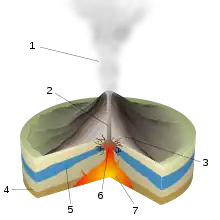

A phreatic eruption, also called a phreatic explosion, ultravulcanian eruption or steam-blast eruption,[1] occurs when magma heats ground water or surface water. The extreme temperature of the magma (anywhere from 500 to 1,170 °C (930 to 2,100 °F)) causes near-instantaneous evaporation of water to steam, resulting in an explosion of steam, water, ash, rock, and volcanic bombs.[2] At Mount St. Helens in Washington state, hundreds of steam explosions preceded the 1980 Plinian eruption of the volcano.[2] A less intense geothermal event may result in a mud volcano.
Phreatic eruptions typically include steam and rock fragments; the inclusion of liquid lava is unusual. The temperature of the fragments can range from cold to incandescent. If molten magma is included, volcanologists classify the event as a phreatomagmatic eruption. These eruptions occasionally create broad, low-relief craters called maars. Phreatic explosions can be accompanied by carbon dioxide or hydrogen sulfide gas-emissions. Carbon dioxide can asphyxiate at sufficient concentration; hydrogen sulfide acts as a broad-spectrum poison. A 1979 phreatic eruption on the island of Java killed 140 people, most of whom were overcome by poisonous gases.[3]
Examples of phreatic eruptions
- Cumbre Vieja - In the 2021 La Palma eruption, new eruptive vents tended to announce themselves with a phreatic explosion, followed soon after by the opening of a new fissure vent in the same location.
- Krakatoa – Indonesia, 1883 (see 1883 eruption of Krakatoa) – it is believed that the eruption, which obliterated most of the volcanic island and created the loudest sound in recorded history, was a phreatomagmatic event.[4][5]
- Ritter Island – Papua New Guinea, 1888 (see 1888 Ritter Island eruption and tsunami) – Resulted in the largest lateral spreading of a volcanic cone in human history.[6]
- Kilauea – Hawaii, United States – the volcano has a long record of phreatic explosions; a 1924 phreatic eruption hurled rocks estimated at eight tons up to a distance of one kilometer.[7]
- Surtsey – Iceland, 1963–65
- Taal Volcano – Philippines, 1965, 1977, 2020
- Mount Ontake – Japan, 2014 (see 2014 Mount Ontake eruption)
- Mayon Volcano – Philippines, 2013
- Whakaari/White Island – New Zealand, 2019 (see 2019 Whakaari/White Island eruption)
- Mount Bulusan – Philippines, 2022
See also
- Types of volcanic eruptions – Overview of different types of volcanic eruptions
- Phreatic – Term used in several scientific disciplines
- Hydrothermal explosion – Explosion of superheated ground water converting to steam
- Steam cannon – a large caliber projectile weapon powered by steam pressure
References
- ↑ Mullineaux, D.R. et al. (1987) Volcanic Hazards in the Hawaiian Islands in Volcanism in Hawaii, volume 1, USGS Professional Paper 1350, page 602.
- 1 2 "VHP Photo Glossary: Phreatic eruption". Volcano Hazards Program. U.S. Geological Survey. Retrieved 13 November 2010.
- ↑ "On February 20th, 1979, 142 inhabitants of Dieng Plateau (Indonesia) were asphyxiated by poisonous gases during a mild phreatic eruption. From later fields gas collection and analysis, the casualties are considered to be due to CO2 rich volcanic gases." F. Le Guern, H. Tazieff and R. Faivre Pierret, "An example of health hazard: People killed by gas during a phreatic eruption: Diëng plateau (Java, Indonesia), February 20th 1979", Bulletin of Volcanology 45 (1982): 153–156.
- ↑ "A precursory phreatic or phreatomagmatic stage has been identified in the 1883 Krakatau eruption (Simkin and Fiske, 1983)". A precursory phreatic or phreatomagmatic stage has been identified in the 1883 Krakatau eruption (Simkin and Fiske, 1983). David J. W. Piper, Georgia Pe-Piper and Darren Lefort, "Precursory activity of the 161 ka Kos Plateau Tuff eruption, Aegean Sea (Greece)", Bulletin of Volcanology 72 (2010): 657–669.
- ↑ Simkin T, Fiske RS (1983) Krakatau 1883: The Volcanic Eruption and its Effects. Smithsonian Institution Press, Washington.
- ↑ Steven N. Ward and Simon Day (2003). "Ritter Island Volcano—lateral collapse and the tsunami of 1888". Geophysical Journal International. 154 (3): 891–902. Bibcode:2003GeoJI.154..891W. doi:10.1046/j.1365-246X.2003.02016.x.
- ↑ "On May 10, 1924, a violent phreatic (steam) eruption began in Halema'uma'u that sent repeated columns of ash high into the sky. The explosions continued for 18 days, with the largest occurring on May 18. The steam explosions hurled rocks as large as eight tons as far as 0.6 miles from the crater; these blocks still surround Halema'uma'u. One of these blocks fatally injured a Mr. Taylor, who approached too close to the crater to take a photograph." Phreatic Eruptions, Hawaiian Volcano Observatory, US Geological Survey, 6 May 1994.